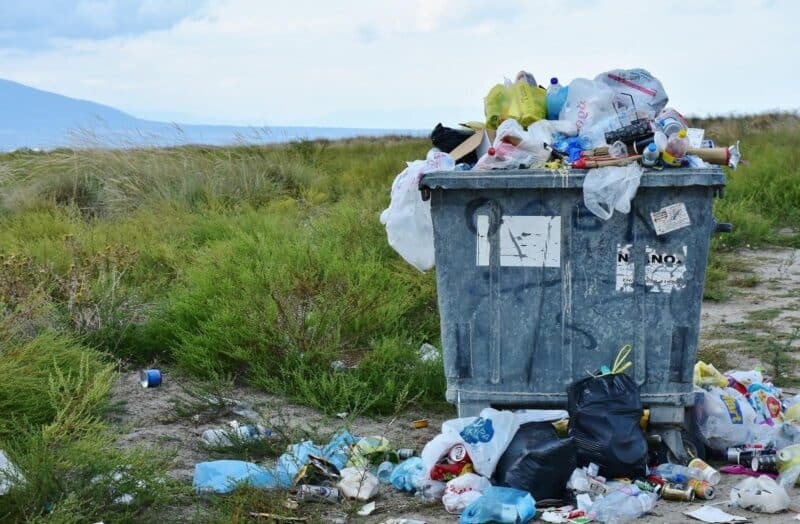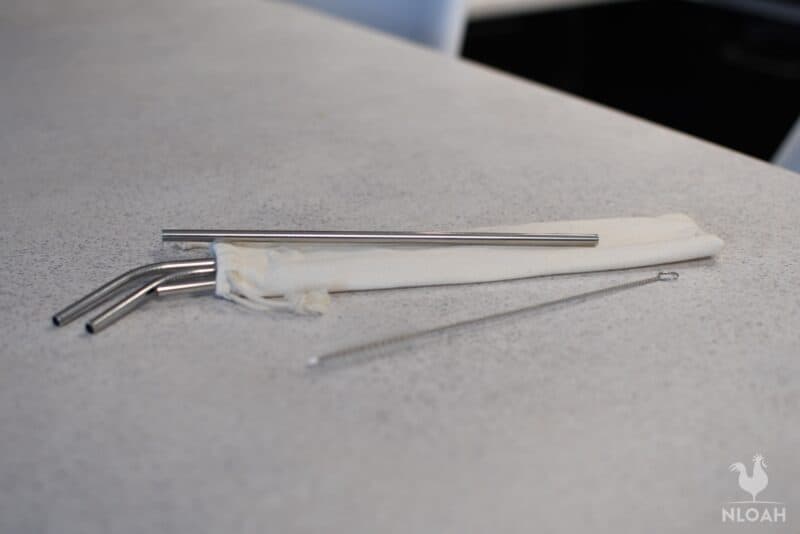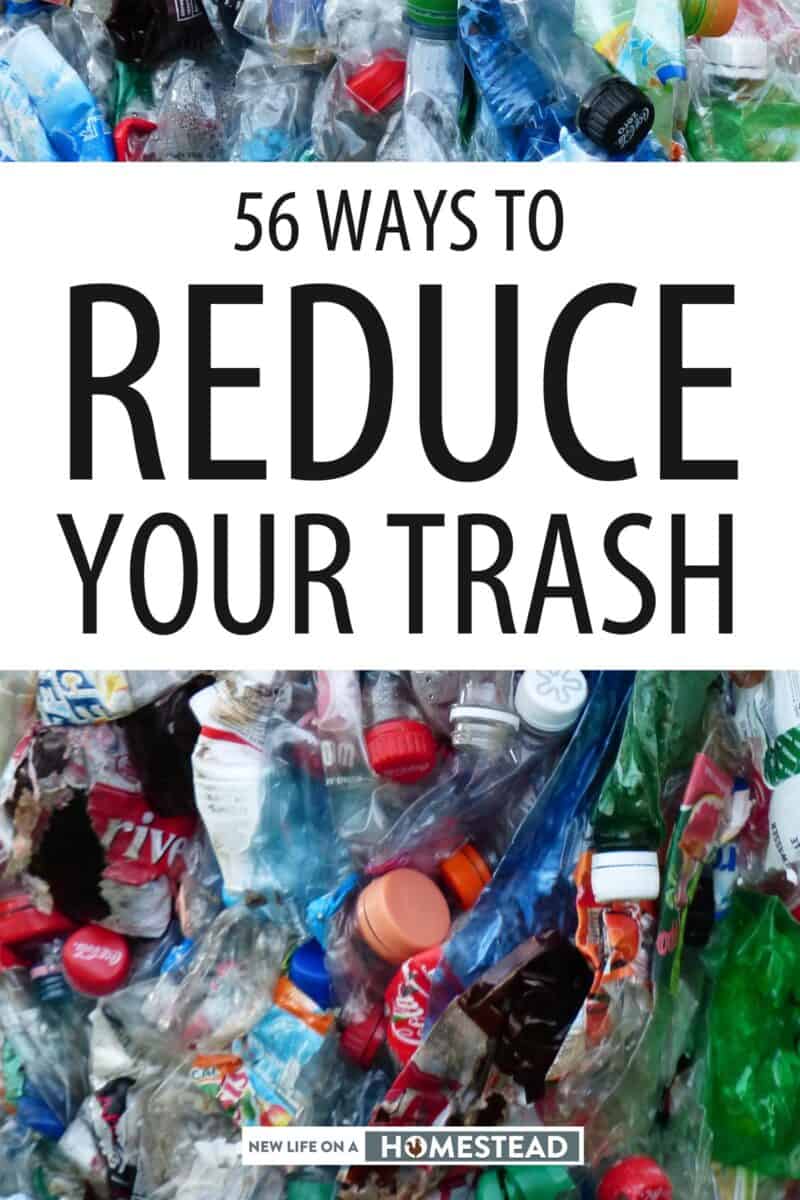If you are looking for ways to reduce your trash, you are not alone! People around the world are looking to create a positive impact on the planet by reducing their waste that ends up in landfills, oceans, etc.
According to the EPA, of the over 290 million tons of solid waste produced in 2018, only 32.1% of that was either recycled or composted. That’s a lot of leftover garbage that gets to the dump and stays there!
So, here is a list of # ways to reduce your trash in change your footprint on the world for the better! There are 4 categories of waste that we will cover in this article.

Table of Contents:
Reducing Household Trash
In the household waste category, we are going to look at the main products that are used in most homes that can be switched for zero-waste options.
One thing that many people think is that environmentally friendly products are more expensive, but that doesn’t have to be the case at all. Just check out our list of ways to reduce household waste and you’ll see for yourself!
1. Shop for zero-waste alternatives to all household items.
The simplest way to do this is when you run out of a product (laundry detergent, shampoo, etc), shop for a zero-waste product instead of purchasing the same product again.
2. Reuse food-grade plastics.
Many foods that come in plastic containers are great for reuse since the plastic is food-grade. Yogurt containers are great for planting seedlings.
Vitamin & supplement containers are great for storing dried herbs and seasonings. The possibilities are only limited by your imagination and ingenuity.
3. Shop for plastic-free alternatives.
Many products come in plastics and other materials. One of the easiest switches is to stop buying products that come in plastics and opt for a better option, like compostable or more universally recycled materials.
Choose the eggs the come in paperboard rather than styrofoam. If you are buying jam, ensure you buy the one that comes in a glass jar instead of a plastic jar.
4. Invest in a water filter.
Don’t go buying your water by the bottle or jug. While plastic water bottles are recycled better than most other plastics, many still end up in the landfill and/or oceans.
For example, Zero Water offers water filters that are easy to recycle but also have the even better option of sending them back to the company to rejuvenate to be sold again!
5. Adopt Minimalism.
While this isn’t a clear-cut tip to reduce waste, the less you consume and the less materialistic products you buy, the less waste you will produce over time. There are many benefits to Minimalism beyond reducing waste as well.
6. Wear sustainable clothing.
Clothes made from natural materials (cotton, hemp, etc.) can be composted, and don’t need to be sent to a landfill when they break down. Clothes made from polyester and other synthetic materials don’t break down, and end up in the landfill for up to 200 years!
7. Second-Hand Shopping
If you want to create an even more sustainable closet, shop second-hand when you can. The fast fashion industry creates tons of trash every year.
Opting for used clothing means no new trash was created for that article of clothing to reach your closet. The same can’t be said for new clothing, even with the best sustainable brands.
8. Implement greywater systems.
While water going down the drain may not seem like trash, it is wastewater that isn’t reused with treatment or the natural process of cycling through the earth back into the groundwater.
Implementing greywater can reduce your wastewater output and reduce irrigation needs for ornamentals or food-producing plants and trees if that’s where you route the water, creating a win-win!
9. Turn some household products into DIYs.
You can make your soaps, lotions, shampoos, and many other consumable products at home with simple ingredients. These products tend to be healthier for you and the environment while producing less trash in the process. You can see a soap-making experiment right here!
10. Recycle better.
Programs like TerraCycle allow you to recycle products that your local municipality won’t recycle themselves.
Many people think that if they throw something in the recycle bin, it’s going to automatically be recycled. This couldn’t be further from the truth. Using TerraCycle will drastically improve the chances of your trash being recycled.
11. Compost the carbons.
All homesteaders know they need a good source of carbon for the compost pile. Things like paper towels, tissues, and junk mail can be shredded and put into the compost pile instead of the garbage can. Recycling is only an option for those pieces that aren’t overly soiled.
12. Opting out of paper mail.
While composting that mail is an option, signing up for digital mail over paper mail is a good way to reduce this waste altogether. You can do this for your bills and even things like credit card offers.
13. No more disposables.
Plates, knives, forks, spoons, and the like shouldn’t be disposable. Invest in a well-made set of permanent dishes and cutlery and stop throwing away countless disposable items.
14. Refill household items.
There are specialty stores that offer bulk items like shampoo, soap, etc for your refillable containers. Many of the so-called single-use containers that household items come in can be rinsed, washed, and put to another use by refilling it and these bulk supply stores.
Reducing Food Waste
Food waste is a huge problem around the world. So much food is thrown away that could be put to better use. Otherwise, it gets sent to the landfill and ends up producing the greenhouse gas methane along with the rest of the trash.
15. Invest in a chest freezer.
The more freezer space you have, the more you can store. The fridge is great but it doesn’t stand up to the preservation of freezing foods!
16. Shop for only what you need.
Don’t buy for a family of 10 when you are only in a family of 3. Buying too much food will typically result in a lot of that fresh food spoiling before you get a chance to use it.
17. Raise an omnivore.
Chickens and pigs are awesome because they can eat a ton of different foods. This means that anything you and the family don’t finish can go to the omnivore on the homestead. Chickens and pigs love snacks whenever they get the opportunity!
18. Compost what you can.
If you can’t raise an omnivore or you have certain foods that aren’t good for your livestock, you can usually compost it.
19. Make broth with leftovers.
Vegetables are typically trimmed, cut, or peeled before use. All of that vegetable waste can be frozen until you have enough to put in a pressure cooker to make a veggie broth. The same goes for meat and bones to make a hearty bone broth.
20. Don’t cook too much.
Just like you shouldn’t overshop, you shouldn’t overcook. Plan your meals ahead of time and adjust the recipe for the number of servings you need to feed the family. A few servings of leftovers are fine but those quickly add up if you continually cook too much day after day.
21. Learn preservation techniques.
Freezing, canning, and fermenting are all awesome ways to preserve your food longer to reduce your food trash output. Learn each and find out what ingredients work best for each technique.
22. Freeze leftovers.
The fridge is nice for leftovers if you plan on eating them within the next day or two. But, if you have the freezer space you can easily store them in the freezer instead and have them last months instead of days!
23. Shop for package-free.
Some grocery stores offer bulk items that you can fill your own containers with. Instead of throwing away a bunch of plastic from the food you buy you can fill it into your reusable containers and avoid that waste altogether.
24. Grow your own food.
Growing your own food reduces the trash used in transport to the grocery store and the trash used in packaging. Plus, fresh food from the garden is so much better!
25. Raise the meat you intend to eat.
The meat industry creates a lot of trash. Think about all of the meat at the grocery store. It is lined with styrofoam and plastic everywhere.
If you raise your livestock for meat and butcher it yourself, you can package it in compostable packaging instead. Alternatively, you can work with a butcher who will do the same for you.
26. Use fewer ingredients.
You don’t need 20+ ingredients in every dish. Plenty of dishes taste amazing using a few simple ingredients. The fewer ingredients used per meal, the less you buy. This means a smaller chance of throwing a bunch of food out.
27. Create a meal plan using the same ingredients.
With the idea of using fewer ingredients per dish, plan ahead with recipes that use the same ingredients over the course of the week.
That way, when you go grocery shopping, you know you are buying an ingredient that has multiple purposes and won’t go to waste after being used in one meal.
28. Never shop without a list.
Simple, yet effective. Shop for your groceries with a preplanned list so you don’t purchase things you don’t need that could end up in the trash can.
Reducing Homestead Trash
While reducing household and food waste is great for the average family, those of us who homestead have another waste stream that has to be dealt with if we want a more sustainable homestead!
29. Choose your livestock food wisely.
Livestock food tends to come in plastic or paper bags. Opt for paper bags whenever possible.
30. Invest in sustainable livestock materials.
Don’t go out and buy a bunch of flimsy plastic stuff for your livestock. A plastic chicken waterer and feeder will break and will end up in your garbage can.
Invest in sturdier material like metal instead. It may cost a bit more at first but it will last much longer.
31. Use natural fertilizers.
Fertilizers always come in plastic packaging with fancy logos to prove they will boost your yields by 10,000% (or whatever nonsense they claim).
If you already have livestock on the homestead you have a free source of renewable fertilizer in the form of manure. It’s always plastic-free!
32. Save garden seeds.
It’s fun to buy garden seeds and plant starts at the nursery. But, much of those packages and pots are loaded with plastics that end up in the landfill. Make your garden more sustainable by saving seeds from your crops to grow in the following years.
33. Grow livestock fodder.
The less livestock food you have to bring in, the less trash you bring in as well. Growing livestock fodder can reduce your feed bill and your trash load. Fodder is awesome for pigs, chickens, rabbits, and plenty of other livestock.
34. Don’t use plastic weed block.
It leaches chemicals over time, and will eventually end up in your garbage can. Instead, use natural mulches or something like kraft paper rolls as an alternative to plastic weed barriers.
35. Don’t buy plastic tools.
Plastic tools always seem to break, no matter how good you take care of them. Spend a little more money on metal tools and you won’t be throwing plastic tools in the garbage can.
36. Think twice about a greenhouse.
Greenhouse plastic degrades over time and can rip, eventually finding its way to the landfill. So, do you really need a greenhouse?
Grow cool-season crops when you should and warm-season crops when you should. A greenhouse is only necessary if you don’t have a growing season!
37. Build sustainably.
Livestock shelters, barns, sheds, and the like are all common on a homestead. Build them out of sustainable materials that can be repurposed if damaged. Otherwise, this stuff might end up in the landfill as well!
38. No plastic bird netting.
Use bird netting made from sustainable materials, like jute. Plastic bird netting is a mess, and ends up being thrown away all the time.
39. No plastic trellising.
Just like bird netting, plastic trellises are made from weak plastic that breaks and ends up in the trash can. There are biodegradable options on the market as a better alternative.
40. Buy bulk bedding.
Farm stores sell bedding like pine shavings in large plastic bags. While this could be an option if you can’t find anything else, try and get bulk bedding without the packaging. For example, many landscaping businesses sell bulk wood chips that will get the job done.
41. Use local food waste.
This is a bonus tip because it doesn’t directly reduce your farm waste and may actually add to your garbage can. However, this waste was already going to your local landfill and you upcycling it reduces the local trash load tremendously.
Food banks, bakeries, and dairies near you throw away tons of food every year. That stale bread, damaged produce, and expired dairy can be fed to livestock on your homestead!
You might be throwing away a lot of plastic bread bags milk jugs, but these were already on the way to the dump. You removed the food and caused less methane production from the landfill!
42. Hand power is just fine.
Plastic oil containers, gas cans, and other fluids required for motorized tools are avoidable by opting for hand-powered tools where possible. You can also choose electric-powered tools if hand power isn’t sufficient.
Reducing Waste On The Go
We all go on vacation, whether it be on week-long trips or a simple night out on the town. Reducing waste outside of the house is just as important as reducing trash output at home for living sustainably!
43. Refuse plastic grocery bags.
Bring reusable bags to the grocery store. Those plastic grocery bags are quite hard to recycle, so avoid them at all costs.
44. Bring reusable cutlery.
When you go to birthday parties, bring your reusable cutlery. Some people may give you funny looks, but it’s not worth breaking your commitment towards sustainable living!
45. Go to environmentally friendly restaurants.
Some restaurants choose to be more eco-friendly than others. Find those in your area and support them by choosing them over the less sustainable restaurants in the neighborhood.
46. Fast food isn’t your friend.
Fast food produces a lot of garbage. Each item comes in its own container that is usually soiled with grease and oils, making recycling nearly impossible. For example, the pizza box made of cardboard isn’t recyclable if pizza grease is on it!
47. Avoid gas-station snacks.
They are typically packed in non-recyclable plastics. Find an alternative or a gas station that sells snacks with biodegradable packaging.

48. No more plastic straws.
This has been a huge topic over the last few years. They are almost impossible to recycle and end up polluting our waterways and killing wildlife.
49. Aluminum over plastic.
Want to buy a tea at the convenience store? Opt for the one in an aluminum can instead of a plastic bottle.
50. Stay in environmentally-friendly hotels.
Check out this list from Business Insider if you want the best of the best! There are obviously others but if you want to travel to many places, these hotels are your best option towards sustainable lodging.
51. Go to eco-friendly destinations.
Just like hotels can be eco-friendly, entire destinations can be eco-friendly. The Travel Channel offers some good ideas for eco-friendly destinations for your next vacation.
52. Spend more time in nature.
Take yourself, some water, and a few snacks and you can spend hours enjoying nature without producing any garbage at all! This is a great alternative to many commercial destinations.
53. Pack an essentials bag.
Keep a packed bag in your vehicle with water, food, first aid supplies, and anything else you could need that could lead to you buying trash-producing goods on the road.
54. Camping is fun.
Go camping and bring all of your sustainably packaged food and drinks. You can spend a few nights in nature, and produce zero trash and enjoy how life was lived for the majority of human history for the most part.
55. Bring your own snacks.
Many places don’t serve sustainable options for snacks. If you can sneak your eco-friendly snacks in the movie theater you won’t be throwing away the popcorn bucket and drink cup like the other movie-goers.
56. Pick up others’ trash.
If you want to leave a positive impact when traveling, dedicate some time to picking up trash. Many people do this at the beach. It can influence others to join in as well!
How Can You Reduce Your Trash Output?
Do you have any other ideas on how to reduce waste? Let us know in the comments and if they are working great for you, we may add them to the article and give you the credit!
Hopefully, you can take a few of these trash-reducing tips and implement them in your daily life. It will help the world around you, and might just improve the quality of your own life as well!

No comments:
Post a Comment